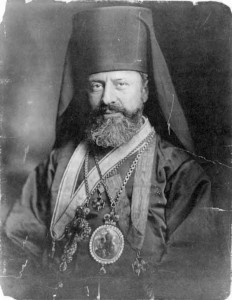St Raphael Hawaweeny was a native of Lebanon, who in 1904 became the first Orthodox bishop ordained in the new world. As Bishop of Brooklyn he had oversight over the Syro-Lebanese communities that were beginning to appear in the Americas in the early twentieth century and he worked tirelessly for their growth and consolidation. It has been noted previously by Matthew Namee on this web site that during the years of St Raphael’s ministry until his repose in 1915 there was a dramatic increase in the extent and use of the English language in the liturgical life of these communities.
Last year, whilst I was researching in the National Archives in London, England, I discovered a document that shows that St Raphael’s missionary concerns extended beyond English to the Spanish language. The document I found was a letter (written in Russian) in 1912 from St Raphael to Fr. Eugene Smirnov, the priest of the Russian Embassy church in London. By way of background it should be mentioned that Fr. Eugene had briefly served as a reader at the Russian Orthodox parish in New York in the early 1870’s under Fr Nicholas Bjerring. Fr Eugene maintained an active interest in Orthodox missionary work throughout his life and in particular facilitated considerable support for the development of the church in America by way of both material and financial assistance.
The letter, which is translated in full below, is evidence of the expansive missionary vision of both St Raphael and Fr. Eugene. I am indebted to Dr. Karina Ross of St George Antiochian Orthodox George in Utica for its translation:
Your Blessedness,
Esteemed Father Protopriest!
The box with five hundred copies of St. John’s Liturgy in the Spanish language that you promised to me in your letter from Feb. 13th / 26th of the current year was conveyed to me yesterday from the Russian Cathedral in New York.
I humbly request you to notify of this the deeply respected – apostles of Orthodoxy in the twentieth century in the heterodox West – splendid general V. Vich(?)-Perez and remarkable warrior of Christ G. A. K (can’t make out the surname), (the life and the conversion to Orthodoxy of the former through the latter, your spiritual son, I described in great detail from its account in “Church News” in my Arabic spiritual publication “Al-Khalimat” (“The Word”) last year), and also to let them know of my deepest gratitude and prayerful blessing.
I intend to send out these copies to our Orthodox Syrian Arabs who are living in Spanish language countries in Northern and Central America, in hope that this very beneficial book with (?) mercy will be of great use for the support of Orthodoxy and, quite likely, for its proliferation among Spanish speakers. Let the Lord of Hosts support all those who labour in Christ’s vineyard.
I sincerely thank you, esteemed Father Protopriest, for the love that you have shown me and for your trust in my unworthiness, with deep reverence and sincere gratitude, yours truly.
Perpetually praying for you to Lord Jesus, Raphael, Bishop of Brooklyn.
To His Blessedness
Father Protopriest
Evegenii Smirnov
32 Welbeck St., London
It is my hope that a reader of this article might be able to find and translate the article of St Raphael in Al-Khalimat” (“The Word”) referred to in the letter so that we might learn the identity of the two Spanish language apostles of Orthodoxy in the twentieth century and thus place this document within the wider context in which it obviously belongs. I am not certain to what extent Spanish is currently employed liturgically in any of the Antiochian Orthodox parishes in the USA and whether any evidence exists of its earlier use that St Raphael clearly intended to promote through the distribution of this translation of the Divine Liturgy of St John Chrysostom.
Nicholas Chapman, Herkimer, NY, August 26, 2012

The Antiochian parish in Mexico City was founded during St Raphael’s lifetime and he mentions it in a couple of his sermons as one of the few parishes under his charge that he regretted being unable to visit.
According to the website for the Antiochian Archdiocese of Mexico, the founder of their cathedral was a man named Simón Iza, who was followed in his endeavor by the priests José Chalhub and Zacarías Antonio Zacarías who were under the bishop Samuel David of Toledo. (http://www.iglesiaortodoxa.org.mx/informacion/?page_id=27). Aside from Mexico, there are Antiochian archdioceses of Argentina and Chile, where I’m under the impression Spanish is the main language.
If someone can provide me with a scan of the relevant issue of al-Kalima, I’d be happy to translate it. I’m quite curious about any contacts St Raphael may have had with Orthodox in Latin America beyond Mexico.
I’m working on getting a copy of the Al-Kalimat article. If anyone out there is at St. Vladimir’s Seminary, the article is probably in their library. Also, of course, at the Antiochian Village.
Also with regard to the beginnings of Antiochian Orthodoxy in Latin America, it seems that the early leader of the Antiochian mission in Argentina and Brazil was Germanos Shehadi, future Metropolitan of Zahle and later long-term visitor to the US. He was recalled from South America in 1904 to be consecrated bishop of Zahle, which occurred on September 12, 1904 at the Maryamiyya Cathedral in Damascus.
The reference for this is Asad Rustum’s History, vol. 3, p. 318.